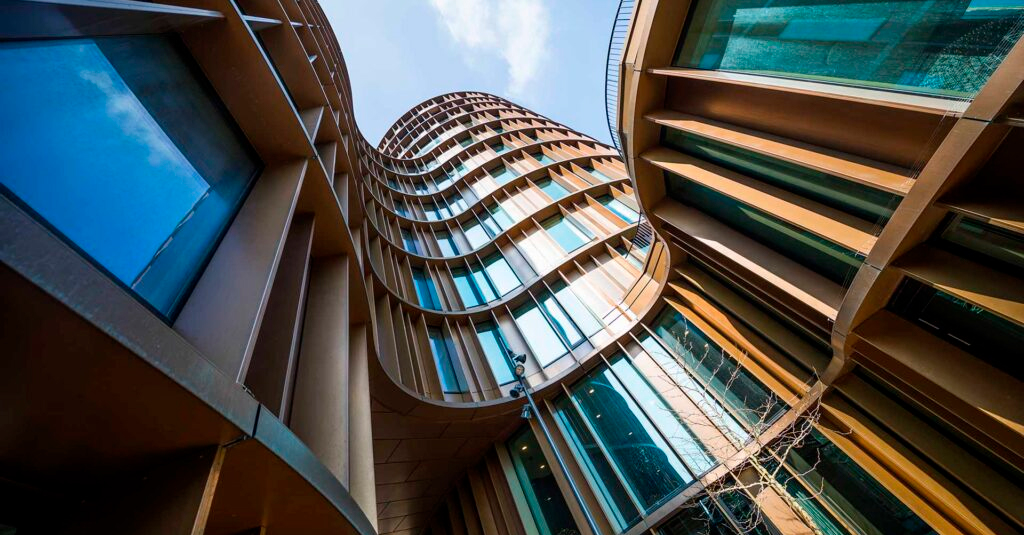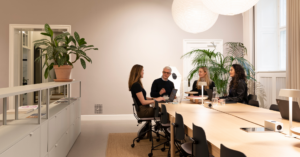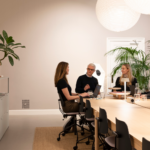Danish design, Nordic Noir, and New Nordic food. Denmark is doing well and we are known around the world for our high quality, beautiful craftsmanship, and minimalistic design. But aren’t we just benefitting from the great work done by designers such as Børge Mogensen and Hans J. Wegner in the 50s, 60s, and 70s?
This spurs interesting questions. What is Denmark’s design DNA as a design nation in 2018? And how should we sell Danish design in the future? These questions were in focus when architect and TV host Ane Cortzen gathered three design experts for a panel debate at Trends & Traditions 2018.
The panel was comprised on David Thulstrup, interior architect and CEO of Studio David Thulstrup, Erik Rimmer, chief editor of Bo Bedre, and Christian Bason, CEO of the Danish Design Center.
See all the highlights here and learn more about what is happening on the Danish design scene right now.
Are we a design nation today?
To zoom in on what characterizes Denmark as a design nation today, a particularly relevant question kick-started the debate on the stage at Lokomotivhallen in Copenhagen.
“Are we able to renew ourselves as a design nation or do we have a tendency to benefit from past masters?”
Ane Cortzen started the debate in her usual challenging way with this intriguing question.All three experts agreed that Denmark doesn’t invest enough in the development of new talents.
“Denmark’s success as a design nation may seem quite random. We must be aware that design talents can come from many different places – and we must get more out these talents by preparing them better to create value when they start working after their education. Otherwise, we let them down,” said Christian Bason.
Is Danish design an illusion?
The panel also discussed whether we in a global, digital time can even talk about a national design, since we can easily get inspiration from a Japanese designer by looking through our Instagram feeds.
“Somehow the idea about Danish design is an illusion. For instance, the couch we are sitting on was designed by the Danish-Italian company Gamfratesi. Are they Danish? Or Italian?” Erik Rimmer asked his co-experts almost rhetorically.
“As an interior architect I have some Danish fragments in my solutions, however, for me it is more interesting to talk about space-specific design. I take my starting point in how the design will be experienced and used. If my customer is a new Chinese restaurant, I will not copy the interior style of the new Noma that I just decorated,” said David Thulstrup.
Christian Bason concluded: “There will always be an interaction between design nations, but we must be aware of our own design nation so we don’t lose something valuable – so we don’t lose our edge.”
3 characteristics of Danish design DNA
Despite the slightly dismal introductory question of whether we are able to renew ourselves as a design nation, the panel agreed that we can still talk about Danish design as something special. Instead of certain materials, what makes it special is more immaterial – it is about the way we approach the whole design process. During the discussion, the panel agreed on three things that are particularly characteristic of Danish design today:
We are attentive and cooperative
As a small nation, we have always had to collaborate with others to be successful. The same applies to the development of new design. With a Danish designer leading the way, customers will be listened to and collaborated with. The customer will experience someone who puts their ego aside to provide the best possible solution.
We are creative with our resources
We live in a small country without wild animals or big mountains. However, we are still able to create groundbreaking experiences and designs – we have a wild imagination that allows us to do a lot with few resources.
We think green and sustainable
Denmark is a rich nation that is able to think big and consider sustainability and green solutions. We are able to create great projects without destroying the environment in the process. This hits a nerve in many countries.
You can watch the whole talk on ‘Design nation vol. 2.0’ in Danish here.









